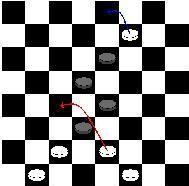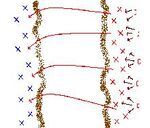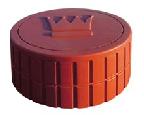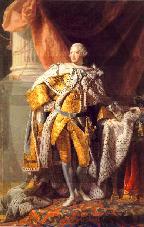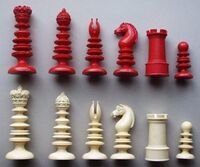Cheka
“Cheka Khan, let me rock you; let me rock you, Cheka Khan”
“Workers of the world, let's dance!!!”
The Cheka was a secretive organization created during the Russian Revolution that induced fear approaching terror in much of the proletariat. However, this fear was misplaced, as Cheka's original purpose was not intimidation but merely to reform a subtle rule of a simple board game.
Humble beginnings
The Cheka was founded in December of 1917, shortly after the Bolshevik party came to power in a disagreement that concerned the game of draughts. Lenin had become frustrated with the game's “compulsory take” rule that he believed made draughts “fundamentally traitorous to the toiling masses” and declared the rule illegal, mandating that citizens of Russia could make any move they wanted, “so long as it was not one that the bourgeois-capitalist scum would make.” Trotsky later showed that one could easily make people take things, by merely lining up soldiers with machine guns in trenches behind them. However, by then the Cheka was too firmly established for his minor qualms to uproot it.
Another rule stated that the black side should start first. Cheka harmonized this with the new Communist reality by changing the dark pieces to red ones.
Curiously, most people think of the Cheka as an instrument of terror, while it began with a mere 23 members with no authority beyond seizing a person’s checkerboard or ration card.
Those sanctions are unheard-of today because they proved ineffective, for reasons that historians still hotly debate. Some argue that no one feared the loss of a checkerboard as there was ample supply on the black market. Others say members of the Cheka rarely actually seized a checkerboard. However, the Cheka did carry out this punishment several times, though the Russian people reacted by improvising draughts sets with factory garbage. These sets were larger than a standard draughts set, and became known as гигантские шашки (giant draughts). “Giant” playing boards later spread to Germany after World War One, developing into Riesiges Schach (giant chess). Come 1939, this would sweep through Europe and a really gigantic chess game would begin in earnest.
The leader of the Cheka, Felix Dzerzhinsky, boasted about fitting all the files for the organisation’s first month of operation within a single briefcase. His original plan to fit them in a folding draughts set was rejected, as it would require removing the game pieces.
Expansion
The first major expansion of the Cheka occurred in February, 1918. Germany and Russia had called a truce for peace talks. The Bolshevik government was split between those who wished to continue the war, thinking that destroying most of the pieces was the best way to make the remainder more equal, and those who merely wanted a higher rank and free cross-country travel. Trotsky, in charge of negotiations, pursued a Third Way that he called “neither peace nor war,” and that everyone else called “stalling.”
Trotsky strode around the negotiating table as if the Russians were winning, and agreed to deals he would later declare unacceptable. He spent his spare time urging German soldiers to both throw off the yoke of oppression and play more Giant Draughts. Both tactics went well, as street protests sprang up; but fewer were against the bourgeoisie than about how big a checkerboard should be before being deemed “Giant.” Unfortunately, the Kaiser moved quickly to counter Trotsky. He built larger playing boards than existed anywhere in Russia, ensuring that whoever won the protests, the checkerboards would easily fit the bill.
With this turmoil settled, the Germans told Trotsky to sign the current draft of the peace treaty or resume hostilities. Things were looking bleak until Trotsky remembered the 1854 World Draughts Championship.[1] He strode into the meeting room and declared that the war was already over and the peace treaty was moot. He stormed out and the Germans did nothing for the two days — apart from preparing their army for a renewed war against Russia. When it began to advance, Trotsky realised the giant mistake he had made.
Trotsky drew up a new decree that proclaimed that “The Fatherland is in Danger!” and called for the summary execution of all “enemy agents, profiteers, marauders, hooligans, revolutionary and counterrevolutionary agitators and non-agitators, and anyone else who does not fall under any of the above categories.” It also banned Giant Chess. Punishment for these offences was the loss of one’s chess pieces, and summary execution, respectively. Whilst the treaty of Brest-Litovsk was signed mere days later, the Cheka now had a permanent place in Russian society.
Changes
Over the coming years, the Cheka expanded even further. At its peak, it numbered 260,000, which is almost as many people as it executed. It also destroyed 340,000 draughts boards and nearly a million playing pieces. However, to move beyond the cities, it made several changes, most importantly to its slogan. Whilst the Bolshevik party was strongest among the proletariat, it lacked support among the more numerous peasants, who favoured the Social Revolutionaries.
Most of these peasants were illiterate and had the distressing tendency to use government decrees as rolling paper for cigarettes. Lenin solved this problem by supplying an expired wall calendar with each new decree. This induced the peasants to keep it unlit for at least the couple of days it took to find someone who could read it. Teaching the “compulsory take” rule to the masses was much harder. When Russians asked Lenin why it was so important to know the rules of draughts, he merely replied:
| “ | A good Communist is a good Chekist at the same time | ” |
The Bolsheviks again reacted swiftly and changed the very rules of the game. As in the land reform of 1917, in 1920 they dropped the “compulsory take” rule. Any piece advanced to King's Row was instead removed from the board. The peasantry embraced the rule — or at least understood it — and the cry of “Король мёртв!” (The King is dead!) was heard at draughts games throughout the country.
End of the Cheka
In March 1921, “the revolution” in the rules of the game induced the sailors at Krondstadt Naval Base to mutiny against the one-party regime the Bolsheviks had become.
Trouble had been brewing for a while, as after the end of the civil war, Russians did not see why wartime measures should continue. The leaders saw “war communism” as the first of many swift moves towards full-fledged Marxism-Leninism and saw the removal of kings from the checkerboard as fit for a society where many hallmark achievements would be immediately punished. In contrast, Russians longed for the times before the war, and old-timers began to protest that they wanted their pieces kinged. Russian draughts in this era came to a practical standstill, even before Russian agriculture did.
Former leftist Nikolai Bukharin came to believe that the new rules added strategy to the game and that it would still be possible to pack a concert hall with spectators. He said that the game “will move at a snail’s pace, but it will move none the less.” Bukharin was also one of the few communists ever to encourage people to “enrich yourselves!”
The Krondstadt rebellion had been a warning: if the Bolsheviks kept on changing the ancient game and its rules, “the reddest of the red” would eventually see even redder. Ultimately, the government moderated, enacting the New Economic Policy, and ceasing to mail out free calendars of past years. However, it wasn’t until 1922 that the Cheka was ended and sailors at Kronstadt could play “the game of our fathers” without stealth.
Shortly after, due to rising star player Alexander Alekhine, the nation switched from Cheka to chess anyway. But Cheka and its staff of 143,000 persons did not vanish but simply got renamed, first as the GPU, then the OGPU, the KGB and finally the FSB, which exists today and whose charter still insists that “nothing is compulsory.”
Footnotes
- ↑ André De Voulin, the reigning French champion, had been losing to up-and-coming American David Lee Smith. Suddenly, after a half-hour considering his position, De Voulin stormed out of the room, declaring, C'est une connerie. Unfortunately, due to the ruling of 1462 (where Vlad “the crusher” Isengorph had won the championship by stabbing his opponent and claiming he had forfeited), he needed the opponent’s agreement to officially count a forfeit. This then became one of only eleven drawn Championships on record.
| Featured version: 12 February 2014 | |
| This article has been featured on the main page. — You can vote for or nominate your favourite articles at Uncyclopedia:VFH. | |

